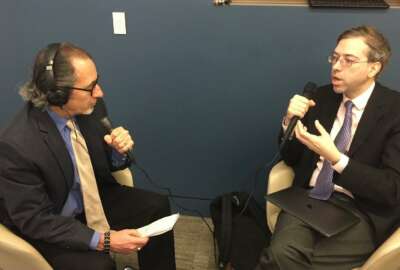
Analytics reveal areas for mission improvement at USDA, VA
The Department of Veterans Affairs is applying artificial intelligence to help improve medical care. The Agriculture Department is giving its eight mission areas...
The Veterans Affairs and Agriculture departments are putting their data to work.
VA is applying deep analytics to health care data to address challenges with the coronavirus. USDA created management dashboards to improve decision making.
Both agencies are seeing the value of artificial intelligence and big data on a larger scale and at an accelerated pace.
Dr. Gil Alterovitz, the director of the National Artificial Intelligence Institute at VA, said during a recent AFCEA Bethesda panel that the agency recently completed an AI tech sprint, which involves VA and private sector companies using agency data.

“One of the organizations just completed a clinical trial matching program which has been evaluated by the Office of Information and Technology looking around different metrics and it was evaluated as being production ready,” Alterovitz said on the panel, which was part of Ask the CIO. “That could empower 9 million veterans once it’s activated to search for clinical trials and experimental therapeutics that may be suitable for them.”
Additionally, the AI tech sprint effort focused on several different efforts over the last year:
- LifeOmic – Built a visualization tool with a machine learning perspective for VA precision oncology data commons
- MyCancerDB – Worked on deploying infrastructure to support the generation and querying of large-scale datasets to enable AI, using a VA precision oncology data commons dataset.
- Oracle Healthcare – Demonstrated an AI-driven customer experience interface to connect the patient and clinician to simplify data driven discussion related to clinical trial options.
- Sanford Imagenetics – Generated a usable product for determination of the relevance of pharmacogenetic testing based on patient characteristics.
Alterovitz said with the AI tech sprint, VA and its partners design a use case, develop the data sets or brought in data from other sources that met the agency’s privacy and security requirements.
The tech sprints, along with other AI-enabled initiatives, is helping the VA better understand how data can work together to drive decisions.
“There is a lot to think about how data sets can work together. Rather than releasing one data set, there is an ecosystem of data sets that are interrelated,” Alterovitz said. “Imagine someone searching for a trial, you have information about the patient, the physician, the demographics, the trial itself, where it’s located — so having all of that put together allows for an efficient use case.”
A dashboard for every USDA mission
Understanding the value of the data and where to find it is central to USDA’s effort.
Ted Kaouk, the chief data officer at USDA, said there is an intense appetite for data, to ask better questions and interact across eight mission areas and 19 agencies.
But too often that data wasn’t available until recently.
USDA launched an initial set of dashboards to the mission areas to give them some data analytics capabilities.
Kaouk said each mission areas receives 360-degree views of their individual metrics and real-time scorecards to more efficiently manage programs and provide customer support.
“We started by asking people and asking leaders across the department, what leaders do they have?” That was a little harder than it sounds. We had to get them to think about what was important to them,” he said. “We tried to open the aperture through divergent and convergent exercises to think about the real questions they were interested in asking.”
Kaouk said USDA used an iterative approach to let the leaders react to the data they were seeing and then ask better and better questions.
“We were able to answer a lot more questions than we thought possible. And by asking those questions, we got to better questions. We also prioritized what data and what questions were most important, and that helped us to think more strategically about how we were going to manage and use this data,” he said. “One of the things we found through a data maturity management assessment was we had a lot of strengths, but had a lot to work on.”
Phase 2 is about data governance
To that end, Kaouk said each mission area now has assistant chief data officers, and his office created an enterprise governance process to oversee and manage the dashboard adoption strategy, to bring information together from an agencywide perspective and build communities of practice for advanced analytics like AI and machine learning.
“People have realized we can do more than we thought and we now know more about what kinds of challenges we have,” he said. “When we started about 18 months ago, there were questions about the value of data visualization. We did a full educational campaign on what kinds of insights are available to people, what time it could save them in terms of pulling manual reports together, best practices for communicating data visually, and we did an internal data visualization competition to train employees on how to use those best practices.”
USDA now is moving to phase 2 of the dashboard project.
“It’s been really valuable for us to have something tangible to govern. There’s been a recognition from leaders across our department that there is a lot of value in our data. They’ve seen it in a real tangible way. So now there is business pressure in the system because expectations have been raised,” Kaouk said. “For us, data governance is the next step to remediate some of the issues we’ve found and to continue to drive that forward.”
He said USDA is implementing a data stewardship framework, which focuses on internal management and providing data to the public.
“One of the things we are trying to be really careful about is showing when we implement data dictionaries and guidance on data, how it enables us to integrate data across the department for the first time in a way we ran into trouble when we went into the dashboards the first time,” he said. “Those leaders in each of the mission areas are standing up centralized analytics teams and we are working as a community across the department to leverage best practices.”
Copyright © 2025 Federal News Network. All rights reserved. This website is not intended for users located within the European Economic Area.
Jason Miller is executive editor of Federal News Network and directs news coverage on the people, policy and programs of the federal government.
Follow @jmillerWFED
Related Stories






